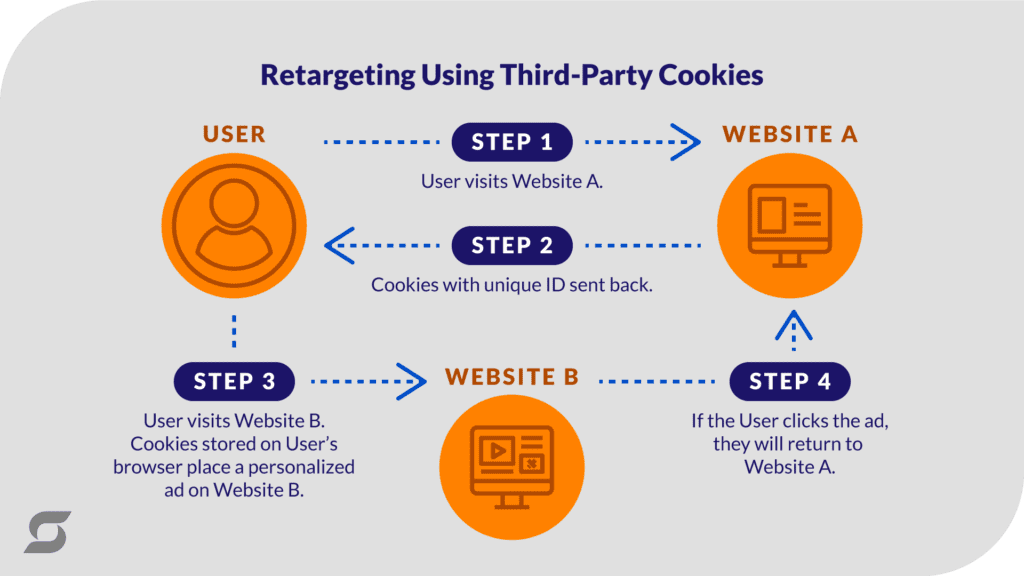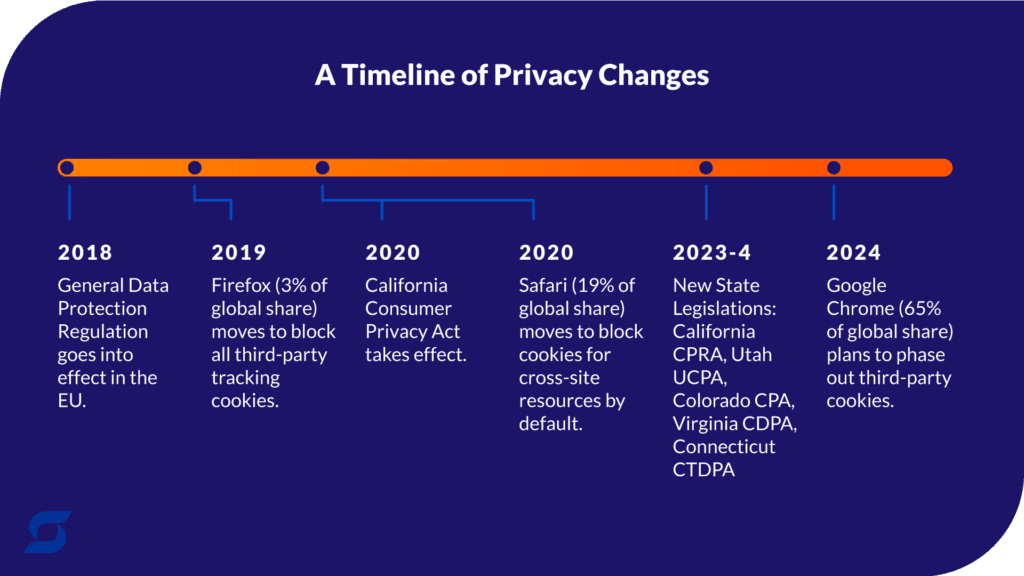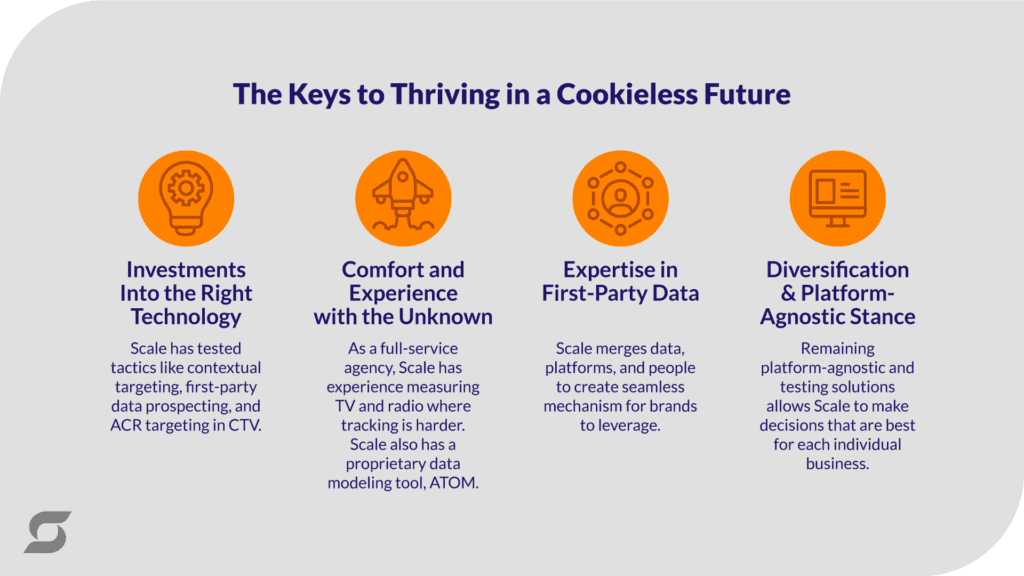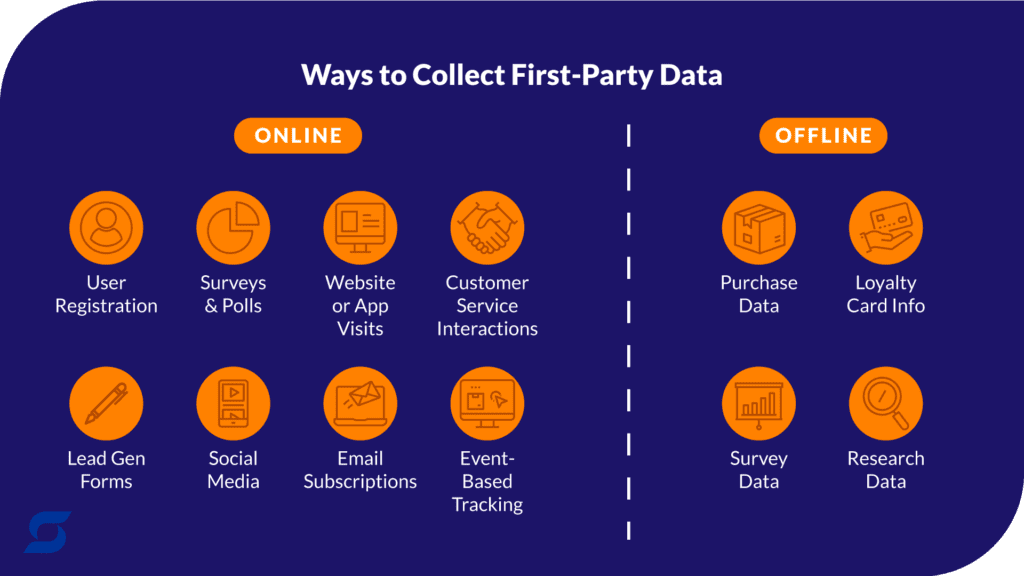In early January 2024, Google began their initial phaseout of cookies. They implemented what they are calling “tracking protection” to 1% of Chrome users (around 30 million users) globally. The plan is to fully remove cookies starting in the third quarter of 2024.
The actual impact of the removal is unknown. We can assume it is a test to measure monetization and user experience impact and will determine if Google stays the course with the planned timeline.
The industry and other technology companies are still skeptical about Google’s Privacy Sandbox solution. While some are embracing it, others are testing (or building) alternative solutions from other DSPs, SSPs, and data providers. Some are putting all their eggs in one basket, Google or otherwise.
What are cookies, and why is this (potentially) such a big deal?
Third-party cookies are created by domains other than the one you are visiting directly. They are used for digital marketing, in cross-site tracking, retargeting, and ad-serving. They allow you to target consumers throughout the web via audience targeting, to gather behavioral data on consumers, and to track the consumer’s journey across devices and sites.
Third-party cookies have been a critical part of advertising and user experiences among the web for 30 years. The use has continuously faced criticism as a non-privacy centric means nor a sustainable method. However, third-party cookies have been so deep-rooted that other privacy measures were enabled to counteract the negative implications, until now
Google’s long-awaited plan for cookie removal is finally here. They have introduced their new offering of Privacy Sandbox and Tracking Protection.
Finding cookieless solutions in itself is not a new concept. DSPs, tech partners, and audience providers have built (or re-built) their offerings on non-cookie based solutions in the wake of the removal.
The “fuss” in the industry is due to Google’s lion-share of internet ownership. Chrome makes up for over 60% of internet browsing, and it is also the largest advertising powerhouse. It owns both an ad server (Google Ad Manager) and a demand-side platform (DSP) as well.
Haven’t we been talking about this since 2017?
Yes, but the cookieless “future” is finally here. Taking measures to prepare will be crucial in order to succeed amid the changes to tracking and targeting.
What is the Privacy Sandbox, and how is the industry reacting?
In simple terms, Privacy Sandbox is a web of connections that demand- and supply-side platforms plug into. They prevent consumers’ personal information from leaking into the ad ecosystem. This will protect consumers’ information so marketers cannot analyze insights about said consumers or implement specific targeting and retargeting capabilities.
After getting feedback from industry players, Chrome has made it possible for advertisers to retarget. However, it won’t be 1-to-1. A retargeting ad will only be served if there is a group of 50+ people eligible to see it.
These changes mean that advertisers and publishers must overhaul their ad tech to comply with Google. That can be expensive and time consuming.
There are concerns that Google’s aim is to privatize the internet. Many worry their approach will harm all players on the internet – consumers, publishers, and advertisers.
According to Trade Desk’s CEO, Jeff Green, “Privacy Sandbox is not innovative. It’s not good for the open internet. And I don’t even see how it’s good for Google. All those brilliant minds inside of a nearly $2 trillion company couldn’t do better than this?”
The main concern is that, along with the dominance of the tech giant, full control of the auction is in Google’s hands. There is very limited visibility of favorability, or hopefully lack thereof. Google has stressed that their DSP does not receive priority. Time will tell as more SSPs and DSPs further test the auction bidding.
What are the solutions today?
Google’s plan to phase out all cookies on Chrome will take full effect by the third quarter of 2024. In many ways, the anticipation has forced the industry to step up to find a viable replacement. Ad tech companies and advertisers are continuing to test the various solutions and determine which is most compatible with their own marketing efforts.
The top alternative solution has been led by The Trade Desk and their UID2.0 solution. In lieu of cookies, it is built off of email addresses as the main identifier.
Lotame is a data management and identity platform, which has built their own alternative ID solution. They have decided to adopt UID2.0 instead of Privacy Sandbox. Lotame’s head of identity, Eli Heath said, “There’s not really going to be a winner takes all in the ID space, and to preserve Lotame audience activation for our buyer clients, we really wanted to take kind of a multi-pronged approach, and I’ll say hedge our bets.”
Viant, another leader in the DSP space, built their identity graph on people-based identifiers (phone number, email, physical address, IP) to build their Household ID. It enables brands to scale and attribute media to deterministic households without the use of cookies.
Across all platforms, media buying is already shifting towards cookieless environment channels, such as CTV or walled gardens. But the measurement and targeting accuracy are still impacted.
The biggest challenge is that we will not know the true long-term impact until cookies are fully removed.
What can you do, and how can Scale Marketing help?
Invest in the right technology:
Scale Marketing holds many seats on the best DSPs out there. They have been vetted for their cookieless solutions.
Data Clean Rooms, DMPs (Data Management Platforms) or CDPs (Customer Data Platforms) are useful for brands looking to further segment their first-party data. CRM systems often have direct integrations with these platforms or even offer segmentation services themselves.
Scale trading teams have continued to test cookieless audiences in the DSP and other platforms on behalf of our clients. We are well-prepared to continue to scale successful digital campaigns. These tactics include, but are not limited to:
- Contextual targeting (serving targeted ads based on page/URL context)
- First-Party Data Prospecting (LALs, Machine learning audiences, Predictive segments)
- ACR targeting in CTV (using hardware technology to competitively conquest, target by content or genre, suppress from linear)
Get comfortable with the “unknown”:
Measurement of digital advertising is likely to take a hit in the months to come. Signal loss and accuracy of conversions will be roadblocks to measuring direct outcomes. We may need to approach measurement like we do for TV, Radio, and many tactics on Meta (due to attribution changes in 2021). We will need to use impressions ran and real business data results to measure return and to optimize our media mix for efficiency.
Data science studies and modeling will play a large role. Tools like Scale Marketing’s proprietary ATOM help determine the effectiveness and synergistic effect of media. They’re especially useful where there are holes in in-platform measurement.
Recognize the importance of first-party data:
Define and execute a first-party data strategy. All brands, regardless of industry, need to have a firm understanding of their customer data. They need a plan in place to standardize taxonomy and implement frameworks for customer segmentation, analysis, and activation.
Brands’ first party data will have enormous value in the near future. First-party data isn’t scalable on its own. The advertising solutions of the future will rely on multiple platforms, people, and sources of data. All must come together to create a seamless mechanism for advertisers to leverage.
Diversify:
Scale plans to remain platform agnostic. Time will tell what the best viable solution or solutions is. By not “picking a side”, we position ourselves and our clients in an advantageous spot. We can make decisions that are best for each individual business and get an unbiased lay of the land.
Get in touch to learn more about how Scale Marketing uses insights to drive growth and business results for companies like yours.







